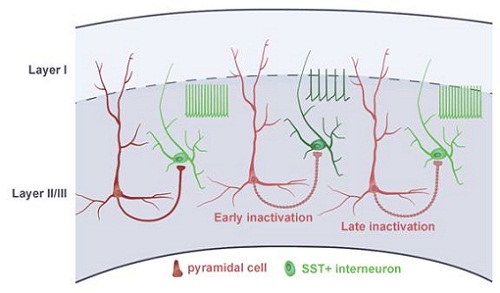A new regulatory mechanism of cortical SST interneuron development
The cerebral cortex has complex cellular structure and circuitry network. GABAergic interneurons, which constitute 20% of the cortical neurons in the rodent brain, exhibit extraordinary diversity in their morphology, histochemistry, intrinsic membrane properties, and connectivity. Thedistinct types of interneurons play divergent roles in cortical networks. Among them, SST+ interneurons differ markedly in several aspects from other subtypes interneurons and play crucial roles in early cortical circuit formation.
A research article entitled "Early Excitatory Activity-dependent Maturation of Somatostatin Interneurons in Cortical Layer 2/3 of Mice" was published online by Cerebral Cortex on December 7, 2018. Pan et al. from Prof. Wang Xiaoqunlab (Institute of Biophysics, Chinese Academy of Sciences) unveils the critical period of the intrinsic development of somatostatin (SST) positive interneurons in the secondary motor cortex (M2) of mice, and provides a new insight into the regulation of interneuron maturation.
In this study, the functional developmental course of layer 2/3 SST+ interneurons of the secondary motor area (M2) in the mouse brain was traced. The authors elucidated the intrinsic electrophysiological properties of SST+ interneurons during the period P1–P30 and highlighted the critical developmental period - before P15 - of SST+ interneuron. Furthermore, bydual recording of SST+ interneurons and local pyramidal cells (PCs), the research group showed that synaptic coupling beganto coordinate the integration of glutamatergic neurons and GABAergic interneurons into nascent cortical circuits at an early stage (~P5/6), with the coupling ratio and synaptic strength increasing during thefirst 2 weeks. Furthermore, the authors demonstrated that attenuating neuronal activity in layer 2/3 PCs at an early stage profoundly influence multiple aspects of the maturation of SST+ interneurons. They observed effects of tetanus toxin (TeNT) injection and Kir2.1 overexpression support the hypothesis that early terminal activity of PCs is one of the factors influencing SST+ interneuron maturation before P1.
This publishedarticle is the first study to illustrate the intrinsic electrophysiological properties of SST+ interneurons during the cortical development, and also to provide a new insight into how PC regulates the maturation of SST+ interneurons. Itcomplementsthe mechanisms of interneuron maturation regulation and sheds lights on how the E/I balance develops in local circuitry.

Dr. PAN Na and Dr. FANG Ai are co-first authors of this paper, and the corresponding author isProf. WANG Xiaoqun. This work was supported by grants from the Chinese Ministry of Science and Technology, the Natural Science Foundation of China and the Strategic Priority Research Program of the Chinese Academy of Sciences.
Article link: https://academic.oup.com/cercor/advance-article/doi/10.1093/cercor/bhy293/5232533
Contact: WANG Xiaoqun, Ph.D, Prof.
Principal Investigator
Vice Director of State Key Laboratory of Brain & Cognitive Sciences, IBP
Function and regulation of neural stem cells in the mammalian brains
E-mail: xiaoqunwang@ibp.ac.cn, Tel:010-64887994
Fax:010-64871293, Zip code: 100101
(Reported by Dr. Wang Xiaoqun’s group)

